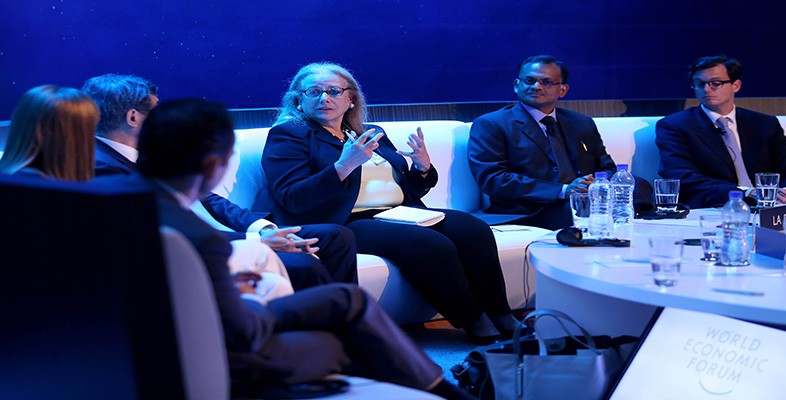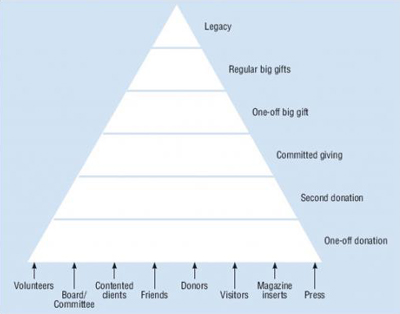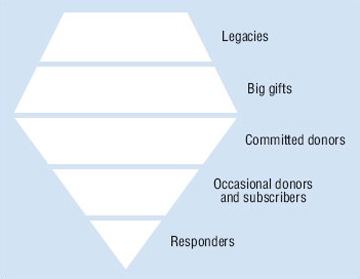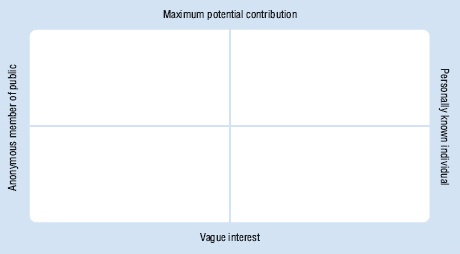3.5 Building the relationship: developing your donors
Donor development is all about ensuring that you and your donors get the most you can from your relationship in ways which are mutually agreeable and beneficial. It is the process by which, from their very first contact onwards, you can encourage and enable donors and supporters to make the maximum contribution they both desire and are capable of.
Effective donor and supporter development depends hugely on your capacity to keep an accurate record of each donor's unique involvement with your cause. Without that information, sensitively used, donor development is not possible.
There are several ways of thinking about the process of donor development. The best known is the classic donor development pyramid (see Figure 3).
The donor development pyramid illustrates some fairly common-sense ideas about the relationship between different types of financial contribution and different levels of donor commitment. It is based on the assumption that, for the most part, the degree of a donor's commitment and loyalty is likely to be in direct proportion to the size of her or his contribution. An organisation will probably attract a large number of occasional donors from various sources (those shown in Figure 3 are just some of the possibilities); fewer will be willing or able to make more regular contributions and commitments; and only a handful will be in a position to make a really substantial contribution.
From the perspective of the donor development pyramid your task is to move your donors as far up the pyramid as they are able and willing to go. Clearly, many of them will be unwilling or unable to move very far up the pyramid; similarly, some people will inevitably lose interest and drift away. As with supporters of any kind, you must therefore ensure that there is constant renewal of support at the lower levels to provide you with a pool from which to draw those whose involvement and contribution can be enhanced.
Before looking at some practical ways of extending people's involvement, let's think a bit more critically about the ideas underlying the ‘pyramid’ approach. Can you see any potential problems? What other factors might you consider when deciding where best to focus your attention and energies? The following discussion stresses how the pyramid model needs to be used with caution and complements it with some other models to guide your effective donor development.
The pyramid represents a ‘bottom-up’ approach to donor development. It rests on your ability to attract and renew a broad base of potential interest and support. What might the process look like, however, to someone who is largely interested not in the numbers of different types of donors and supporters but in the overall size of their respective contributions? Remember the Pareto principle (sometimes called the 80:20 rule): that roughly 80 per cent of your income is likely to come from only 20 per cent of your supporters.
A hypothetical end-of-year report on income raised from individual donors is shown in Table 1.
| Source of income | Number of donors | Total value |
|---|---|---|
| Legacies | 5 | £4500 |
| New contributions to ‘500 Club’ | 15 | £7500 |
| Individual Gift Aid and direct debits | 50 | £5000 |
| General membership subscriptions (£25) | 100 | £2500 |
| Casual donations and collections | 200 | £1500 |
In terms of the numbers of contributors involved, the report seems to match the donor pyramid quite accurately. But a pyramid shape would certainly not illustrate the overall value of their various types of contribution. It required the contributions of 300 people to raise £4000; but the bulk of the income – £17,000 – actually came from just 70 people (and of that amount, well over half came from only 20 people). In terms of the value of different groups of donors, the image is not so much a donor pyramid, but something more like a donor ‘kite’ (see Figure 4).
Seen in this way, you could mount a good case for a ‘top-down’ approach to donor development. ‘Getting more people involved’, in order to secure commitments to regular membership, direct debits and donations from your casual contributors, will require considerable amounts of work – letters, visits, phone calls, and so on – for comparatively little return. Perhaps your energies should be primarily directed to identifying and cultivating those who are likely to be capable of contributing legacies and major donations? Perhaps you should build outwards and downwards from that form of contribution rather than using the pyramid's ‘broad base of support’ as your starting point?
Of course, neither approach is mutually exclusive. The point to bear in mind is that increasing donor and supporter involvement is not simply a matter of recruiting more and more people and moving them up a predetermined ladder. It is seeking to secure both an appropriate mix of contributions and the maximum contributions feasible, wherever you pitch your initial request. A third approach to donor development can be illustrated by a donor matrix (Figure 5). The horizontal axis is the ‘getting to know someone’ axis and the vertical axis is the ‘developing their maximum potential contribution’ axis. It is possible to use this matrix in several ways. By plotting where a donor is at any one time, you can get an idea of where and how best to focus your energies.
The matrix can also suggest how to approach the business of developing donors and supporters at different stages of their involvement. For example, the potential of those who fall into the bottom left-hand corner is largely unknown. You will need to adopt an exploratory approach with a view to identifying the most appropriate channels for their future involvement from amongst the widest possible range. Those in the top left-hand corner are probably traditional armchair supporters. It will be important to acknowledge their desire to remain at arm's length while sustaining the level and type of their contribution. Exhorting them to become more participative could well be counter-productive. Those in the top right-hand corner are obviously to be valued and nurtured as they will, in different ways, be the core of your support. Those falling in or moving towards the bottom right-hand corner are problematic. They should not be automatically ignored. But they could involve you in considerable work; there will come a point when you judge it is no longer worth your while investing more time and effort in sustaining your relationship with them if they show little or no inclination to move upwards.
As with the pyramid and the kite, the donor matrix is a way of identifying some of the key issues and choices underlying your work in developing donors.
Activity 4
Look back through this section and consider the relevance of the ideas and models for your own communication with donors. Either work through the four elements of the process approach (Knowing who to approach, Deciding what to ask for, Communicating your request and Building the relationship), noting in your Learning Journal how you might use the ideas, or take one of the three donor development frameworks: the pyramid, the kite or the matrix, and apply it to your own organisation and its donors.



